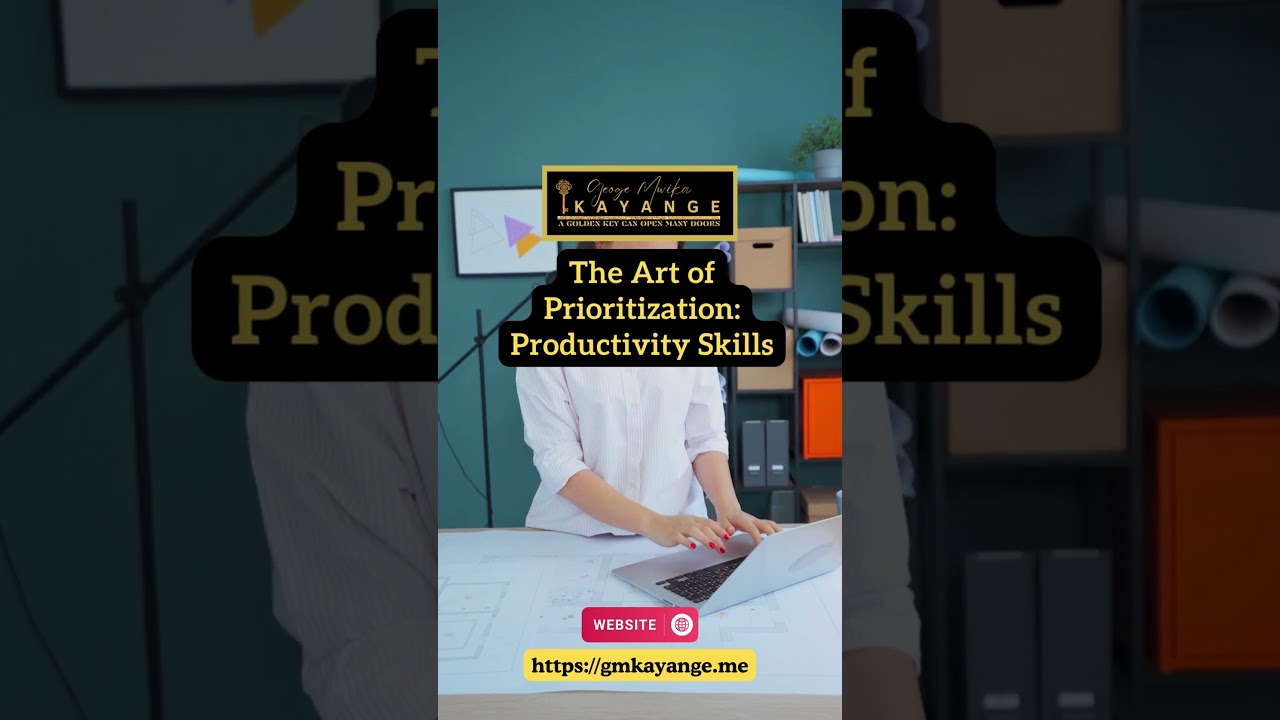
So, you want to learn the art of prioritisation, huh? Well, you’ve come to the right place!
In this video, brought to you by the one and only, STAY PRODUCTIVE! –– With George Mwika Kayange, you’ll discover the essential skills to boost your productivity and maximise your precious time through the art of prioritisation.
No more wasting hours on pointless tasks or getting overwhelmed by a never-ending to-do list.
I’ve got your back with practical strategies to manage your tasks like a boss.
But hey, don’t just take my word for it—subscribe now and unlock your full potential!
In this video, I outline the key points you need to know, from identifying and ranking your essential tasks to ruthlessly focusing on high-priority ones.
And hey, if that’s not enough for you, I’ve even shared some book recommendations to keep the motivation flowing. So, buckle up and get ready to become a productivity ninja!
Art of Prioritisation: Identify and Rank Your Most Important Tasks
I must identify and rank my most important tasks as an incredibly busy person. I just can’t drumroll, doing whatever I feel like doing, right?
I need a clear sense of what must be done and what can wait until later.
So, step one in my quest for productivity is to list all the tasks I need to tackle.
Now, let’s be honest. I have a lot on my plate. It sometimes feels like juggling multiple tasks, from work to personal commitments.
But fear not, my dear friends; I have a foolproof method for determining what’s truly important. That method is called the art of prioritisation using the Urgent-Important Matrix, AKA the Eisenhower Matrix.
Art of Prioritisation: Use the Urgent-Important Matrix to prioritise
The Eisenhower Matrix is like my superhero cape regarding the art of prioritisation. This magical tool helps me separate the urgent from the important and the not-so-important from the not-so-urgent. Let me break it down for you.
First, I divide my tasks into four quadrants: urgent and important, important but not urgent, urgent but not necessary, and neither urgent nor essential. Now, the first quadrant is where the real action happens.
These tasks are urgent and crucial, so naturally, they demand my immediate attention. It’s like putting out fires left and right while maintaining my calm and composed demeanour.
Next, we have the important but not urgent tasks. These require some planning and strategising. They may not be screaming for attention right this second, but they’re still important in the grand scheme of things.
Think of them as slow burners that simmer in the background, waiting for their time to shine.
Now, let’s move on to the urgent but not important tasks. Ah, yes, the bottom of the barrel.
These tasks may seem urgent, but we all know they’re unimportant. So, I mentally whip out my superpower of discernment and delegate these tasks to someone else. Why waste my precious time on something that doesn’t move the needle?
And finally, we have the tasks that are neither urgent nor important. These are the ones that I ignore, blissfully basking in the knowledge that they can be pushed to the bottom of the priority list—the sweet taste of freedom.

This image is property of i.ytimg.com.
Be ruthless in focusing on high-priority tasks
Now that I’ve identified my most important tasks and used the Urgent-Important Matrix to prioritise them, it’s time to put on my ruthless hat.
Yes, you heard me right. When focusing on high-priority tasks, I don’t mess around.
I’ve learned that tackling too many things at once is a recipe for disaster. It’s like playing a never-ending game of whack-a-mole, and trust me, I always end up whacking myself in the process.
So, instead of spreading myself thin and pretending to be a productivity superhero, I narrow my focus and zero in on the tasks that truly matter.
But here’s the kicker: being ruthless doesn’t mean being unkind. I’m not advocating for steamrolling over my colleagues or neglecting my responsibilities.
It simply means making tough choices and setting clear boundaries. It means saying no to distractions and staying laser-focused on what’s important.
And hey, if that means indulging in a little power trip along the way, who am I to complain?
Regularly re-evaluate your priorities as circumstances change
Life can be full of surprises. When we think we have everything under control, something throws a wrench in our perfectly crafted plans.
Fortunately, my productive pals, I have a secret weapon: regular priority re-evaluation.
You see, circumstances change. Deadlines get moved, emergencies pop up out of nowhere, and new opportunities knock on our door.
And if we’re not careful, we can find ourselves stuck in a never-ending cycle of playing catch-up.
So, to avoid falling into that trap, I regularly reevaluate my priorities. I step back, assess the situation, and adjust my to-do list accordingly.
It’s like being a master chess player, always thinking ten moves ahead. And let me tell you, it feels incredibly satisfying to stay one step ahead of the game.

This image is property of images.pexels.com.
Avoid overcommitting and diluting your efforts
Alright, folks, I’m about to drop some truth bombs. Brace yourselves.
Overcommitment is the sworn enemy of productivity. I repeat, over-commitment is the dreadful foe of productivity. It’s like a sneaky little leech that drains our time, energy, and sanity.
I used to be chronically overcommitted. I would say yes to every request, invitation, and opportunity that came my way. I thought I was a real go-getter but was spreading myself thin and diluting my efforts.
But, my fellow productivity warriors, I have learned the mistakes of my ways. I now follow a simple mantra: less is more. I focus on a few key projects, give them my undivided attention, and watch the magic unfold.
By avoiding the temptation to take on too much, I free up precious mental bandwidth and create space for true greatness to emerge.
The Art of Prioritisation & Delegating Tasks
Delegation is like a magic trick that makes tasks disappear into thin air. And let me tell you, my friends, it’s a skill worth mastering.
You see, I used to be a control freak. I wanted to do everything myself, convinced that I was the only one who could get things done right. Oh, how wrong I was.
I’ve since learned that delegating tasks is not a sign of weakness but strength. It allows me to focus on what truly matters and empowers others to shine in their areas of expertise. Who am I to rob someone of the joy of conquering a task and basking in the glory of success?
So, I’ve embraced the art of delegation as much as the art of prioritisation. I identify tasks that don’t align with my priorities and pass them on to someone else. It’s like a weight lifted off my shoulders, allowing me to soar to new heights of productivity.
And, if it means I can occasionally kick back and enjoy a cup of coffee while someone else takes care of business, I’m not one to argue.

This image is property of images.pexels.com.
The 7 Habits of Highly Effective People: Powerful Lessons in Personal Change by Stephen Covey
Stephen Covey. The man, the legend. His book, “The 7 Habits of Highly Effective People,” is like the productivity bible.
It’s chock-full of wisdom and practical advice that can transform even the most scatterbrained into productivity powerhouses.
From habit number one, being proactive, to habit number seven, sharpening the saw, Covey covers all the bases. He teaches us how to take control of our lives, prioritise effectively, and cultivate meaningful relationships.
It’s like a crash course in personal and professional growth wrapped up in one neat little package.
So, if you want to level up your productivity game, I highly recommend diving into Covey’s world and his seven habits. You may purchase a copy of this life-changing book at this link: https://amzn.to/3U3LVUY (affiliate link).
Trust me, you won’t be disappointed.
Deep Work: Rules for Focused Success in a Distracted World, by Cal Newport
In today’s hyper-connected world, distractions are everywhere. It’s like trying to navigate a minefield while juggling flaming torches. It’s not exactly a recipe for focused success.
My fellow productivity seekers, the good news is that Cal Newport has come to the rescue with his book Deep Work: Rules for Focused Success in a Distracted World. Newport lays out a roadmap for achieving deep work, which he defines as the ability to focus without distraction on a cognitively demanding task.
He provides practical strategies for eliminating distractions, managing time effectively, and honing concentration skills. It’s like a crash course in mindfulness for the productivity-obsessed.
So, read Newport’s book if you’re tired of feeling like a squirrel on steroids, constantly hopping from one task to another. You can get it here: https://amzn.to/47Z2KUx (affiliate link). Your brain will thank you.

This image is property of images.pexels.com.
Getting Things Done: The Art of Stress-Free Productivity by David Allen
Raise your hand if you’ve ever felt overwhelmed by the sheer amount of stuff you must do. Yep, that’s a lot of hands. Well, fear not, my overwhelmed friends, because David Allen is here to save the day with his book, “Getting Things Done: The Art of Stress-Free Productivity.”
Allen introduces a system for capturing, organising, and executing all the tasks and ideas that come our way. It’s like having a personal assistant in book form, guiding us through the maze of productivity.
He teaches us the power of the mind-sweep, the beauty of the next-action decision, and the art of creating context-specific to-do lists. It’s like having a productivity toolbox at our fingertips, ready to tackle any challenge that comes our way. So, if you’re tired of feeling like your to-do list is a never-ending black hole, read Allen’s book. Here is the purchase link: https://amzn.to/3Uaa24u (affiliate link).
Conclusion
And there you have it, my dear productivity enthusiasts. A comprehensive guide to mastering the art of prioritisation and boosting your productivity. We’ve covered everything from identifying your most important tasks to delegating like a boss.
We’ve delved into the wisdom of Covey, Newport, and Allen, and walked away with practical strategies for success.
So, my friends, go forth and conquer. Take these tips and tricks, weave them into the fabric of your daily life, and watch as your productivity soars to new heights.
Remember, you can shape your destiny, one prioritised task at a time. Stay productive, my friends!
By learning these essential skills, you can effectively manage your tasks and maximise your time. Don’t miss this opportunity to unlock your full potential – subscribe now!
In conclusion, here is a recap of the main points I outlined in the video “The Art of Prioritisation: Productivity Skills,” in which I share valuable insights to help you boost your productivity:
- Identify and rank your most important tasks.
- Use the Urgent-Important Matrix to prioritize effectively.
- Be ruthless in focusing on high-priority tasks.
- Regularly re-evaluate your priorities as circumstances change.
- Avoid overcommitting and diluting your efforts.
- Delegate tasks that are not in line with your priorities.
YOU CAN SIGN UP FOR WEEKLY UPDATES ON MY LINKTR.EE HERE:
https://linktr.ee/georgekayange?subsc…
AFFILIATE DISCLOSURE:
This article contains affiliate links, meaning I’ll receive a small commission if you click on one of the product links. The affiliate relationship does not influence my opinion, and I would not endorse programmes, products, or services I didn’t use or feel familiar with. This helps support this blog (website) and the YouTube channel and allows me to continue making videos like this. So, if you use my links to support me, thank you.
George Mwika Kayange is an International Development Professional and Project Management Specialist with over 20 years of experience working with various national, regional, and international NGOs. He is also a Commonwealth PhD Scholar at Loughborough University, London.
